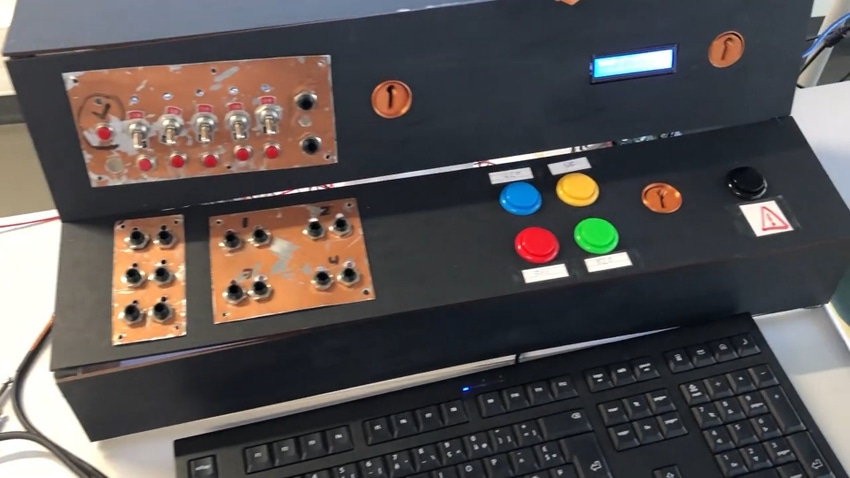Atomik gives players a complex series of buttons, connections, keys, and pedals to keep a nuclear reactor from melting down. Better read the manual quickly.

The 2023 Game Developers Conference will once again feature Alt.Ctrl.GDC, an exhibition dedicated to games that use alternative control schemes and interactions in new, exciting, and clever ways. Ahead of GDC 2023, Game Developer will be talking to the developers of each of the games that have been selected for the showcase.
Atomik gives players a complex series of buttons, connections, keys, and pedals to keep a nuclear reactor from melting down. Better read the manual quickly.
Game Developer sat down with the game's developers, Jérémy de Frémont and Léo Toulisse, to talk about what thoughts went into designing a control scheme that was meant to feel overwhelming, what sorts of actions create that sense of complexity simply by looking at them, and the appeal of adding a language barrier and manual to the mix.
What’s your name, and what was your role on this project?
de Frémont: I’m Jérémy de Frémont, the main game designer and one of the controller makers.
Toulisse: My name is Léo Toulisse and I am the main programmer for Atomik.
How do you describe your innovative controller to someone who’s completely unfamiliar with it?
de Frémont: The goal of the game is to repair an unstable nuclear power plant. The player must pay attention to what is happening on-screen and read the manual to understand what to do with the control panels.

What's your background in making games?
de Frémont: I am a Year 4 Game design student. I’ve been making games throughout this course, but this is the first physical/alternative controller game I have made and my first participation with GDC.
Toulisse: I have been making games for 4 years as part of my school curriculum, as well as in my free time. I have also participated twice in Games Made in France for various projects, but it’s my first time going to the GDC and I'm very excited to be there!
What development tools did you use to build Atomik?
de Frémont: Because our game is mostly made of physical assets, we used very [little] software. We did use Photoshop and Illustrator for the manual and in-game UI. We also used the Unity game engine to develop the game.
Toulisse: The game itself was made using Unity, but we also used Arduino to communicate with the physical parts of Atomik, like the buttons, switches, and LCD display. We also used Illustrator, InDesign, and Photoshop to make the manual and the assets for the game.
What physical materials did you use to make it?
de Frémont: The machine itself is made of painted wood, and we added many cables and electronic parts like an LCD screen and different buttons. We also added metal plates and switches to give it a cooler look.
Toulisse: There are also some 3d printed pieces here and there and lots of electronics and wires to link all of that to the computer running the game.
What inspired the creation of Atomik, a game about navigating complex problems at a nuclear plant?
de Frémont: We wanted a game where the player would use different senses that would overwhelm them. A nuclear power plant—that’s a complicated tool to manipulate, even moreso when it’s about to blow up. We got the inspiration for the manual by looking at different references from old soviet power plants.

What drew you to make a controller that was very complicated?
de Frémont: That’s the thing: the main idea was to make a complicated game that required your focus at 200%. The player must read and understand the manual, resolve the different problems along the way, and resolve them well.
Toulisse: I like games that resist the players, but here, the difficulty resolves in filtering the useful information to use and understanding what you are supposed to do with it. I think having a more complicated-looking controller builds into this idea and reading the manual slowly makes you understand what you are looking at.
How did you choose the things the player could do? Choose what interactions you would put into the controller?
de Frémont: For diversity's sake, each module needed to be different: a configuration of lights where you must find the right sequence of cables and switches, a secret code to decipher and type on a keyboard, and a complexified Simon game with chemical elements. While solving these problems, players must also repeatedly press a pedal with their foot to keep the screen on.
Toulisse: We thought about what kind of interactions are fun to play with, and we played a bit with the cool factor of connecting cables and using switches and buttons to make the player feel like they are doing something complex. I would have liked to have had way more modules to play with, but time (and simply not wanting to have too big of a machine) made us do only four.
Further, what drew you to use a language players may not understand for the game itself? Why make them translate things before being able to use the manual?
de Frémont: We aimed for a “50’s soviet building” vibe, so we used the cyrillic alphabet for the code module. Players don’t need to understand it—just find the matching letters to type on the keyboard.
Toulisse: The only time the player is required to translate things is for one of the modules, but it is done using the manual (which is written in English). Other than that, the different texts you can see here and there in cyrillic are mostly there as decorations and don't particularly help the player. So it’s fine if you can’t read it!
What thoughts went into the things the player could do in the game? How did you make gameplay so complicated that it would necessitate such a complex controller?
de Frémont: The first thing we noticed on the power plant pictures we used as reference were the number of buttons and switches—how complex it all looked. The “physical” aspect of the game, where you have to constantly do something, naturally came to us. We also wanted to strip down the panels from any unnecessary elements useless to the gameplay or the experience.
Toulisse: It was kinda backward to be honest. We wanted a complex controller and made the game to fit our needs. We thought big machines like nuclear reactors looked complicated enough and got inspired by that to make it into what it is today. The puzzles were also created so that they seemed like they would have their place in a nuclear facility. As for the way to solve them, it was mostly about what felt good to play with.

The gameplay puts a great deal of pressure on the player, with the complexities of the problems they fix combined with the difficulties of managing the controller to fix them. What appealed to you about pushing the player with these challenges?
de Frémont: Honestly, I just wanted players to use their feet—you don’t see that very often as classic controllers always require you to use your hands. In the end, the gameplay got really diverse and here is the result today!
Toulisse: We often just make games because, at one point, we thought “I like this kind of game, I wish there were more.” And here it is. But obviously we also think about making the game accessible to more people than just us, so we had to tweak a bit some of the ideas that went into the game to appeal to more people and I think the result was worth it.
Despite these complexities, Atomik is designed to be fair. With so much to manage, how did you balance the challenges so that they were taxing but not frustrating?
de Frémont: The game gives you a short time at the beginning to get familiar with the manual and the UI. We also designed mistakes to be amusing in this game, so you just need to hit a button to stop the alarm. There’s not a lot of consequences to that except the small waste of time.
Toulisse: Atomik is mostly designed to have fun playing in a different way than what we are used to, so we aren’t really punishing the player for the mistakes they might make. A single game should last between 3 and 5 minutes, and by this point you should have mastered most of the game's mechanics, so if you don’t succeed on the first try you can just try again !
Has building a game around a unique controller taught you anything unexpected about game design?
de Frémont: The “physical” gameplay is really special to imagine—very different from a game played with a classic controller. It needed to be fun to interact with the machine. I really think we nailed that part.
Toulisse: I have never worked with physical and electronic elements before, so it was a fun experience! It gave me the opportunity to learn about Arduino and realize that it really wasn’t that much different or complicated than what I was used to. But for a controller like this, the focus was much more on what feels great to manipulate—whether we should use a simple button or a pedal you have to press with your feet.
Read more about:
[EDITORIAL] Alt.Ctrl.GDC 2023About the Author(s)
You May Also Like







